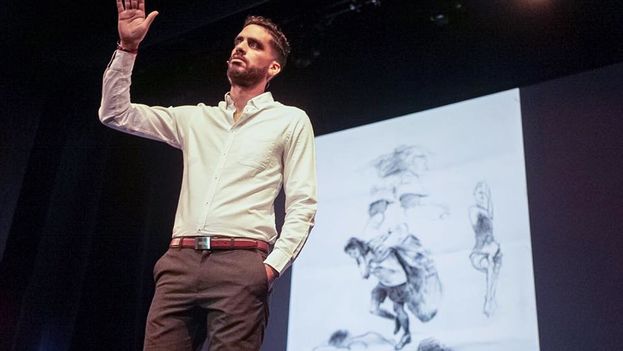
![]() EFE (via 14ymedio), Maria Tejero Martin, Oslo, 24 May 2016 – Danilo Maldonado is known as El Sexto the name engraved in ink on his skin and that he paints on the walls of Havana to plant an idea of freedom in his compatriots, like a seed that flourishes and breaks the “dangerous myths” that, he says, surround Cuba.
EFE (via 14ymedio), Maria Tejero Martin, Oslo, 24 May 2016 – Danilo Maldonado is known as El Sexto the name engraved in ink on his skin and that he paints on the walls of Havana to plant an idea of freedom in his compatriots, like a seed that flourishes and breaks the “dangerous myths” that, he says, surround Cuba.
When he was nine he caused his mother grief when he drew Fidel Castro in his military uniform but with the head of a monkey; by his twenties he had decided to turn himself into the antihero El Sexto (The Sixth), in response to the regime’s campaign to free Los Cinco (The Five), Cuban agents arrested in the United States. continue reading
In his thirties, after the United States initiated contacts with Cuba after years of the embargo, Maldonado “knew I would go to jail” he told EFE, when he was inspired to paint the names “Raul” and “Fidel” on the backs of two pigs for a piece of Orwellian inspired performance art which he was unable to carry out.
“The worst thing is that I never got to release them, but I went to jail, I went to jail for something that never existed, without cause or role,” explained Maldonado, who was declared a prisoner of conscience by Amnesty International.
His incarceration prevented him from collecting the Vaclav Havel Prize for creative dissent a year ago in Oslo, and today he is in the Norwegian capital for the first time, where he is participating in the Oslo Freedom Forum, although he says that he has already attended this annual forum of activists and defenders of human rights “in conscience.”
This is a basic word for this artist who considers himself a “prisoner of conscience” who seeks to “awaken” the conscience of Cubans and open the eyes of foreigners whose romanticism prevents them from seeing that the vintage cars that circulate around Havana “means that we are stuck in time.”
Meanwhile he draws on a page, showing the Little Prince that he carries on his long lean arm. And if, as Antoine de Saint-Exupery’s character would say, “the essence is invisible to the eyes,” Maldonado feels that his mission is to attack just there, on the plane of abstract consciousness, where he “works with things that don’t exist to make them a reality.”
Like freedom in Cuba, he laments, although he is “sure” that art will first bring rights to the island and later allow them to become reality, in the same way, he explains, that he conceived the hunger strike he undertook in prison as a work of art titled “Mao’s awakening.”
“I said that if consciousness could change what is, it should save me from there, I would die because I would have been talking complete shit. The bars have to opened by the hands of the repressor himself, only in this way will art exist. And so it happened,” he affirmed.
Maldonado believes that art can serve as a catalyst for any change, like a predecessor, and says that “an idea can destroy what exists.” Even the regime.
“I want to bring down a dictatorship that has lasted for a very long time in my country, demystify it and demystify the false canons it was selling, like that of Che Guevara,” says El Sexto.
“Often it sold [the idea] that wearing green and roaming the world with weapons was cool. And it is not cool. Cool was a guy like Martin Luther King, Mahatma Gandhi or Christ. But cool is not the type of people who believe they are rebels and what they are is a murderer who wants to impose his idea,” he added.
Maldonado does not mince words, either to defend the caricatures of Muhammad or to charge his followers who have spent centuries killing in his name.
“That is what I don’t want to have happen in my country, that I die and that fucking nutcase passes as a savior. What I want is that my art demystifies and destroys him, leaves his essence in the base and that people understand he is not good,” he says, referring to Castro.
For him, he is confident that “art can do anything,” even with some “very dangerous myths.”
“They manage to go on for so long that if people don’t chip away at them they are more dangerous dead than alive. But an idea can destroy and undermine anything (…) That is why they fear me and follow me. They took me prisoner because they know of this influence,” says the artist, who says he will continue living in Cuba and will give his life for what he considers his duty: “Awakening” consciences.
